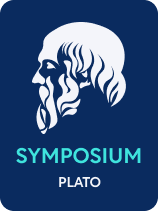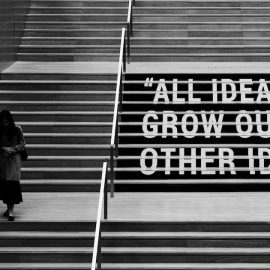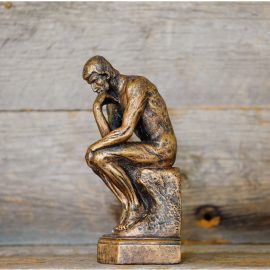

This article is an excerpt from the Shortform book guide to "Symposium" by Plato. Shortform has the world's best summaries and analyses of books you should be reading.
Like this article? Sign up for a free trial here .
What is the “Ladder of Love” in Plato’s Symposium? What are the six steps of Diotima’s Ladder? What kind of love does each step represent?
Diotima’s Ladder of Love is a metaphor for different types of love that originated in Plato’s Symposium. It conceptualizes love in terms of progressive stages or steps: The higher the steps, the higher and the more sophisticated one’s love is.
Keep reading to learn about Diotima’s Ladder of Love.
The Ladder of Love
Diotima explains that the best way to pursue beauty requires a journey of self-realization that she calls the “ascent”: A process of learning to love beautiful things that are more and more good and meaningful.
- An ascendant’s natural desire for beauty inspires them to create intellectual offspring—in other words, it inspires them to develop their rational abilities and do philosophy.
- A long-term dedication to reasoning and thinking about beauty eventually allows the ascendant to understand what beauty itself actually is—and since all good things are beautiful, an understanding of beauty itself allows the ascendant to understand what goodness itself is.
- Diotima describes this understanding in terms of intellectual reproduction—in the presence of absolute beauty, the pupil can birth intellectual offspring that are absolutely and universally true.
Anyone who completes the ascent has a happy life (a meaningful life well-lived). By that point, they’ll have created intellectual offspring that are permanently and absolutely good—because these offspring reveal eternal truths about goodness itself. Creating eternal and good offspring gets a human as close as they can to immortality.
| Beauty Itself and Plato’s Forms To understand what Plato means by beauty itself and how this informs the ascent, we can look to his theory of the forms: The idea that all particular things exist in reference to eternal ideals. For example: Any circle that we see in the world is imperfect—it has tiny little flaws that keep it from being perfectly circular. Plato suggests, however, that a perfect circle does exist in another realm—the form of the circle. All of the particular circles in our world imitate this form, and that’s what makes them circles—they have, to a limited extent, some of the same circle-like qualities. In the context of beauty: All beautiful things are beautiful because they have some qualities of the form of beauty. The more an object aligns with the form of beauty, the more beautiful it is. However, the form of beauty doesn’t just exist as a standard to describe beautiful things—it exists on its own as the most perfectly beautiful thing ever. Beauty comes from this abstract, ideal form instead of being inherent to any specific characteristic like “colorful” or “tall.” In fact, Plato suggests that specific characteristics only distract from the form of beauty. The ascent, then, allows a person to strip away specifics by loving more and more abstract things until there are no specifics left to distract from the form of beauty (beauty itself). |
The Steps of Diotima’s Ladder
Diotima’s Ladder of Love consists of six steps:
1) Love of one beautiful body: First, an ascendant is physically attracted to one beautiful body, inspiring them to create intellectual offspring.
2) Love of all beautiful bodies: The ascendant will eventually recognize that there’s no reason to desire one physically beautiful body more than another since they all share beautiful attributes in common. Therefore, the ascendant comes to love all beautiful bodies.
3) Love of all beautiful minds: As the ascendant continues to reason and birth mental offspring, the focus of their desire will shift from physical beauty to mental beauty—they’ll start to love wise and moral individuals regardless of their physical appearance.
4) Love of beautiful activities and institutions: Once the ascendant appreciates the beautiful minds of wise and moral people, they’ll come to appreciate the activities, laws, and systems in their society that create these beautiful minds.
5) Love of beautiful knowledge: The ascendant will realize what creates beautiful minds, activities, and institutions—knowledge. From there, they’ll love the beauty of human knowledge and will seek it out.
6) Love of beauty itself: By pursuing beautiful knowledge and birthing intellectual offspring, the ascendant expands the scope of their knowledge and reason until they can finally understand something of beauty itself. This abstract concept of beauty is perfect, eternal, and unchanging—all beautiful things take part in it, but they’re all flawed in comparison.
(Shortform note: Scholars often debate the following question in discussing the steps of the ascent: When someone ascends, do they stop loving objects in the previous steps? For example, does someone on the fifth step no longer love individual people? Some scholars suggest that the ascent provides a strict hierarchy and that ascendants will stop loving individuals in favor of abstract objects or theories. Others argue that while the ascent does prioritize abstract ideas, it doesn’t prevent an ascendant from loving an individual. From this perspective, the ascendant can still appreciate the beauty of the lower steps—they’ll just spend less time doing so as they ascend further.)

———End of Preview———
Like what you just read? Read the rest of the world's best book summary and analysis of Plato's "Symposium" at Shortform .
Here's what you'll find in our full Symposium summary :
- Plato’s philosophies on love, happiness, education, and reproduction
- Agathon’s description of Eros, the god of love
- What it means to love beauty itself






